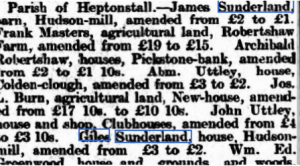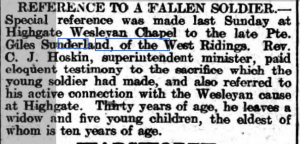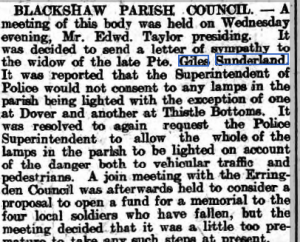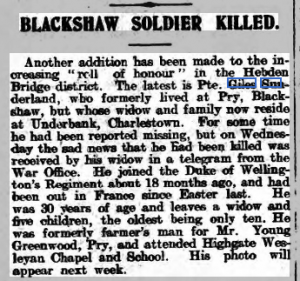Florence Sunderland

4 Melbourne Street
This week I discovered a new line of research in my ancestry. Ok, it’s tenuous in that I don’t share a direct bloodline with my new-found relatives. The connection is through marriage but just how close I now live to these relatives is amazing. Yesterday I went out in search of where they lived. In genealogy terms Florence Sunderland is the mother-in-law of my 2nd cousin 3x removed – 1883-1942. She was born in Blackshaw Head from where I’ve taken several walks along the tops. By the time she was 8 she was living in a cottage just at the far end on Heptonstall, Spink House next to .Colden Wesleyan ChapelHighgate. Recorded on 20th June 1891, when the corner-stones were laid for a new Chapel and SchoolI couldn’t find it on the map, but a posting to the Heptonstall Facebook site soon elicited several responses, one from someone who used to know the family that lived there at one time. Her father was cotton manager secy (secretary?) Mother is Sarah, and siblings John Smith (14), James (13), Ben A. (12) Annie (9) and younger brother Giles, (5). In the census Spink house comes directly after the baptist chapel. Then there are 4 more Spink houses before Colden. Florence married a man whose surname was the same as her maiden name. Sunderland is a common name in this part of West Yorkshire and I’ve visited the ruins of Sunderland Hall, which most Bronte experts believe was the genesis for Wuthering Heights. In 1901 she was living at Mytholm Lane, at what appears to be the last house on the census route before it reaches King Street. She’s living with her 5 siblings and widowed father, Abraham Crabtree Sunderland, an insurance agent. All the siblings work in the cotton/fustian mills, and her youngest brother, Giles, aged 15 is a cotton twister. Surprisingly there is no employment listed for Florence herself.
Florence married at St Thomas’s Heptonstall on November 24, 1906 (just a month after the big earthquake in San Francisco). At the time of her marriage her father gives his job as mill manager and they were living at Prospect Terrace, Savile Road, Hebden Bridge. Her new husband was James Arthur Sunderland of Melbourne Street, Hebden Bridge,though his father is named as John Greenwood, cotton weaver. Present at the wedding were Hannah Sunderland, (Florence’s sister)and John Smith Sunderland (Florence’s brother).

12 Brunswick Street is the first house in the terrace
1911 sees Florence, husband and young daughter living at 12 Brunswick Street, so off I went to find it. There it was, a four storey end of terrace only one street away from where I spent the summer in an AirBnB two years ago! She is listed in the 1911 as working as a wholesale clothier (fustian). In the late 19th century, fustian production was one of the most important industries for Hebden Bridge and the Calder Valley – so much so that the town became known as Fustianopolis. Fustian is a variety of heavy cloth woven from cotton chiefly prepared for menswear. Corduroy is a fustian fabric.

Melbourne Street clothing works built by the Wrigleys, now apartments
1939 she is still living at 4 Melbourne Street employed as a wholesale clothing machinist, and husband James Arthur, is a dyer’s labourer. Brunswick Street is the next street to Melbourne Street. This was the street that led to my AirBnB two years ago, so I passed her house every day. Melbourne Street was the site of a large fustian mill that has now been converted to apartments, so I would presume she and her husband worked at that mill. I haven’t found a record of her husband’s death yet, but Florence remarried at the aged of 56, dying two years later in the house on Melbourne Street. The next thing I discovered was that my Wrigley ancestors actually built the clothing factory on Melbourne Street!
Giles Sunderland

Hike to Scammerton farm

Scammerton. This building was originally the barn

View from Scammerton farm

Chickens in the barn

This area of flat land was the site of the original farm house

Current owner

Cross Stone church

Overgrown
Her brother, Giles, died in WW1. He is remembered on the Thiepval Memorial, France. It seems unthinkable that a young man who lived at Scammerton farm in Heptonstall should die on the battlefields of France. 418 men from Calderdale lost their lives in WW1. Hope Chapel, next door to me, is honouring them all in November and a display is being organised with as many photos as possible. I wonder if someone will share a photo of Giles. Ah ha. I found one in the local newspaper! Three years later Florence’s other brother, John Smith Sunderland, died, aged 42. He’s buried at Cross Stones church, Todmorden, a church set high on the hill above the town – a hill that I haven’t yet climbed! Ah, ha! Have now!  It’s a couple of weeks later now, and, in possession of a new camera the first place I tried it out was Scammerton Farm, Blackshaw Head. I was fortunate that the farmer was at home and interested to share his knowledge about the history of the farm, from its origins on property owned by Lord Saville, to his own purchase of it in the mid 1980’s. It’s set back from the road, a road I’ve walked quite a few time during the last year, and he explained that what is used as the farmhouse now was originally the barn. He pointed out a flat area of ground closer to the road which had been the original location of Scammerton Farm.
It’s a couple of weeks later now, and, in possession of a new camera the first place I tried it out was Scammerton Farm, Blackshaw Head. I was fortunate that the farmer was at home and interested to share his knowledge about the history of the farm, from its origins on property owned by Lord Saville, to his own purchase of it in the mid 1980’s. It’s set back from the road, a road I’ve walked quite a few time during the last year, and he explained that what is used as the farmhouse now was originally the barn. He pointed out a flat area of ground closer to the road which had been the original location of Scammerton Farm.

Stoodley Pike from Cross Stone cemetery

From the Todmorden News, Oct 7, 1910

24 Nov, 1916. Todmorden and District News

Todmorden and District News Nov 10, 1916

Todmorden and District News 10 Nov, 1916
Giles was born in 1886, the youngest of 7 siblings, and closest in age to Florence. Though I find a registration for his birth in the first quarter of 1886 in Todmorden records I haven’t located a baptism yet, neither for Giles or Florence. 1891 see the family living at Spink House, just above Heptonstall, next to the baptist chapel, and the year after, when Giles was only 6 years old his mother Sarah Hannah nee Smith died. 1901 finds 15 year old Giles living with his family on Mytholm Lane as a cotton twister. The next house in the census list is King Street so presumably the Sunderlands are living in the first house on Mytholm lane. Giles married Alice Mary Spencer in Halifax Minster on October 7th 1905. I’m playing for the Remembrance day service in Halifax Minster this year on November 11th. How serendipitous to think that my relative married in that building 11 years before his was killed in WWl. Giles was 19 and Alice was 25. They had two daughters and a son over the next three years, Arthur, Maud and Hilda. 1910 sees the family living at a house at Hudson Mill. The mill has been partially demolished and rebuilt as a residence, but it’s next on my list for a photo shoot! (See next posting)They are still there in 1911, with Giles still employed as a cotton twister, most lively in Hudson Mill itself. However, by 1915 the family have moved from the steep narrow darkness of the Hudson Mill valley to the bracing air on’t’tops, living at Scammerton farm, Blackshaw Head. That information is from the 1915 electoral register. He was a private in the 2nd Battalion of the West riding Regiment when he was killed ‘in action’ on 12th October, 1916. His widow Alice is named as the sole beneficiary of his effects. He was buried at Thiepval, Departement de la Somme, Picardie, France – a long way from Scammerton farm, both physically and metaphorically.
I found several newspaper articles commemorating Giles, one making reference to Giles and his family living at Pry. I’d never heard of the place so I put a call out on Heptonstall facebook and within 24 hours I had several helpful comments including these two from people who had connections with Pry: Clive Oldfield “Half way up Mytholm steeps. Ingram’s live there. Off to your left as you go uphill, just after the short steep bit of road. My grandad moved from the south as a young man to work at Pry Farm, and from Linda L Sayerwas Howorth “A lot of my Sunderlands were born at Spink Houses in the 1800’s.” I was also informed that David and Linda Ingram currently live there. After, knowing roughly where to look on the map I found Pry farm, and lo and behold it’s the next farm along Badger Lane from Scammerton Farm. I suppose it’s just possible that the records are confusing Pry with Scammerton since they are adjacent.


Leave a Reply